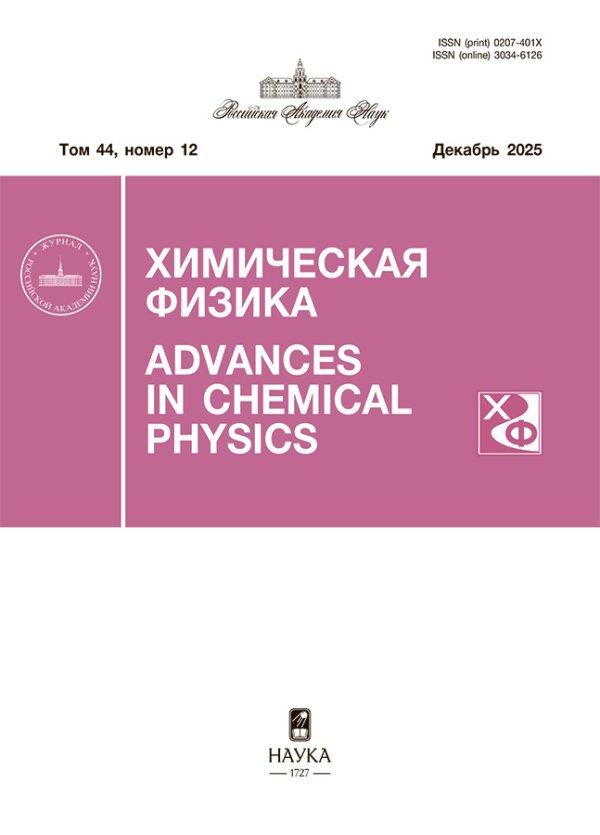Himičeskaâ fizika
ISSN(Print): 0207-401X
Media registration certificate: No. 0110275 dated 02/09/1993
Founder: Russian Academy of Sciences, Federal Research Center for Chemical Physics named after. N.N. Semenov RAS
Editor-in-Chief: Buchachenko Anatoly Leonidovich
Number of issues per year: 12
Indexation: RISC, list of Higher Attestation Commissions, CrossRef, White List (level 2)
The journal publishes articles on the following topics:
- elementary physical and chemical processes
- structure of chemical compounds, spectroscopy, quantum chemistry
- reactivity, influence of external fields and environment on chemical transformation
- molecular dynamics and molecular organization
- dynamics and kinetics of photo- and radiation-induced processes
- mechanism of chemical reactions in the gas and condensed phases and at interphase boundaries
- chain and thermal processes of ignition, combustion and detonation in gases, in two-phase and condensed systems
- shock waves
- physical methods for the study of chemical reactions
- biological processes in chemical physics
The journal is designed for researchers, graduate students and students specializing in the study of the kinetics and mechanism of chemical reactions, energy transfer processes, the structure of matter, catalysis, combustion and detonation processes, transformations in shock waves
The journal is designed for researchers, graduate students and students specializing in the study of the kinetics and mechanism of chemical reactions, energy transfer processes, the structure of matter, catalysis, combustion and detonation processes, transformations in shock waves.
Current Issue
Vol 44, No 12 (2025)
Элементарные физико-химические процессы
THE EXISTENCE REGIONS FOR TRANSCOMPLEX RECOMBINATION OF HEAVY IONS. OPACITY FUNCTIONS AND COMPLEXITY FUNCTIONS
Abstract
 3—19
3—19


ВЛИЯНИЕ ВНЕШНИХ ФАКТОРОВ НА ФИЗИКО-ХИМИЧЕСКИЕ ПРЕВРАЩЕНИЯ
EFFECT OF NANOCARBON ADDITIVES (GRAPHENE, FULLERITES) ON THE EFFICIENCY OF ENERGY-SATURATED COMPOSITIONS OF POROUS SILICON WITH BARIUM AND SODIUM PERCHLORATES UNDER THE TREATMENT OF PULSED ELECTRON BEAM
Abstract
 20—24
20—24


Kinetics and mechanism of chemical reactions, catalysis
QUANTUM CHEMICAL SIMULATION OF REACTIONS IN A NANOGOLD–HYDROGEN–CARBON-OXIDE–OXYGEN SYSTEM
Abstract
 25—29
25—29


ANTIOXIDANT ACTIVITY OF NITROXYL RADICALS DURING THE OXIDATION OF TETRAHYDROFURAN IN AQUEOUS SOLUTION
Abstract
 30—36
30—36


Combustion, explosion and shock waves
STUDY OF THE FLAME PROPAGATION SPEED OF A MIXTURE OF HYDROGEN AND FLUORINE
Abstract
 37-44
37-44


INFLUENCE OF MECHANICAL ACTIVATION, SAMPLE COMPRESSION AND ALUMINUM CONTENT IN THE METAL BINDER ON COMBUSTION PROCESS AND PHASE COMPOSITION OF SYNTHESIS PRODUCTS IN THE (Ti+2B)+(Fe+Co+Cr+Ni+Alx) SYSTEM
Abstract
 45-57
45-57


Chemical physics of biological processes
NATURE OF THE SELECTIVE CYTOFOXITY OF HETEROPOLYCOMPOUNDS
Abstract
 58-68
58-68


Chemical physics of polymeric materials
IDENTIFICATION OF FOREIGN PARTICLES FROM THE GAS-AIR PASS OF A GAS TURBINE ENGINE BY IR-FOURIER-SPECTROSCOPY
Abstract
 69-77
69-77


Химическая физика атмосферных явлений
DYNAMICS OF EXCITED STATES OF CH2OO, CH3CHOO AND (CH3)2COO KRIEGE INTERMEDIATES
Abstract
 78-89
78-89


METHOD FOR EVALUATING THE EFFICIENCY OF HYPERSPECTRAL IMAGING INSTRUMENTATION FOR DETECTING GAS CLOUDS AND PLUMES
Abstract
 90-108
90-108


Short Communication
INFLUENCE OF SOLVENTS ON THE STRUCTURE AND SENSORY PROPERTIES OF INDIUM OXIDE PRODUCED BY THE HYDROTHERMAL METHOD
Abstract
 109-112
109-112












